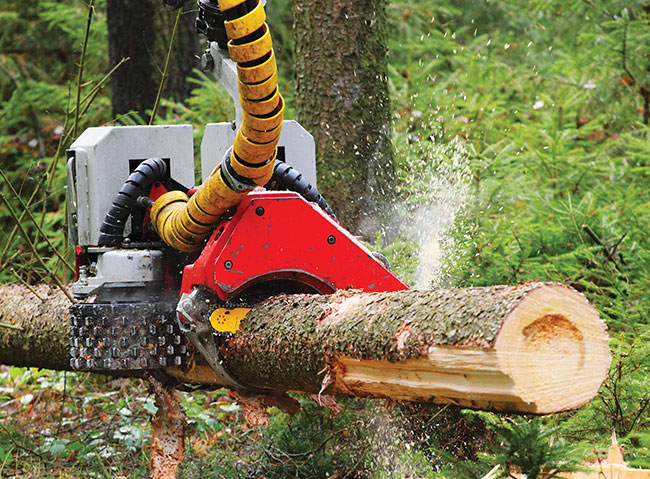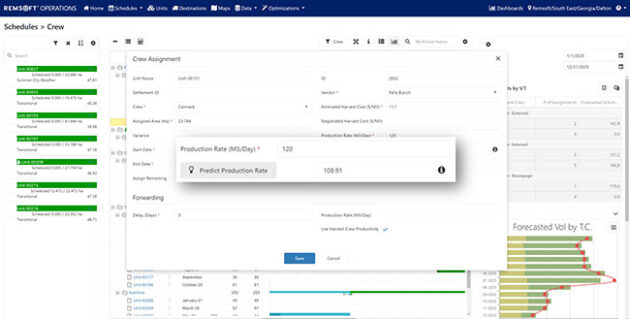
Features
Forestry Management
Harvesting
Harvest accuracy and AI
Helping planners predict when a harvest operation will be late or early
March 21, 2023 By Elliot Sullivan
 AI adoption continues to grow across industries. Images courtesy of Remsoft.
AI adoption continues to grow across industries. Images courtesy of Remsoft.
Artificial intelligence (AI) has become common place in our daily lives, from the advanced driver-assistance systems in modern vehicles to the AI-powered audio and video recommendation engines deployed on the many online streaming services available today. It has even crossed over into the world of art with OpenAI’s system, DALL·E, which generates original artistic images from a text description.
Its impact is broad and burgeoning. A recent article and survey by McKinsey & Company found that AI adoption continues to grow across industries, with impacts both on revenue and cost. There was a significant increase in respondents who reported using AI for at least one function in their business, up 50 per cent from 2020, with use cases ranging from service operations, supply chain management and product development, to manufacturing and corporate finance.
Applying AI
While AI has broad applicability across the forest sector, of particular interest to operational forestry is its potential to improve the forest-to-mill supply chain by leveraging the volume of data already being collected daily. For example, AI can improve the inventory estimates at a stand- and unit-level by augmenting growth and yield models with actuals from the field. It can also use the hourly and daily data from the harvest to make more precise predictions about productivity.
Increasing the accuracy of unit volume and productivity predictions by five or 10 per cent can have a considerable impact on the overall schedule.
This can lead to cost-savings by reducing the effort generated by the constant need to react to volume shortfalls or crews that complete their assignments earlier or later than expected. More critically, it also decreases the risk of not meeting client commitments, missing the window to load a ship at berth, or needing to shut down a mill due to lack of volume.
This will ultimately give planners more confidence in their schedules and alert them to delays that could jeopardize deliveries.

Using AI to generate harvest volume and productivity predictions on-demand.
Predictive analytics and insights
Artificial intelligence is a broad domain that includes topics like machine learning, machine vision, speech recognition, natural language processing, amongst other capabilities.
Machine learning relies upon the use of historical data to train a model and use it to make some prediction about the future. There are several algorithms used in machine learning, all of which allow the computer to learn from the data without being explicitly programmed.
It is due to the predictive nature of machine learning that the term “predictive analytics” is often used alongside it. However, a useful side effect of creating predictive AI models is that compelling diagnostic information is also generated.
These insights can help inform planners as to the specific factors and attributes that are driving the predictions, answering questions such as “what are the attributes that impact productivity?” and “what factors caused our planned volumes to differ from our actuals by 20 per cent?”
This is referred to as feature importance and can be more broadly understood in the context of model explainability (XAI), a concept focused on understanding and analyzing the predictions and results of an AI model. By answering these questions and understanding the importance of each attribute, the AI models can be further enhanced as part of the overall continuous improvement cycle.
An appetite for data
Regardless of the approach or algorithm used, machine learning is hungry for data and thrives on platforms that make data accessible. It also benefits from adding further data to the model as it becomes available.
Certainly not all data will be useful or drive the predictions being made, but this cannot always be known until the model has been trained and the feature importance has been evaluated.
And while most experienced foresters can accurately describe most of the attributes that impact the production rate of a harvest unit in their forestland, there will always be some surprises.
As such, it is good practice to use as much data as is available when training an AI model and refine it as the results are analyzed. Fortunately, in operational forestry, there is a significant volume of information coming off a harvest unit every day.
To truly bring value to a forest operation, AI models need to be brought out of the lab and into the hands of the planners as they are making crucial day-to-day decisions.
This “just-in-time” availability is frequently the difference between AI being seen as an internal academic exercise undertaken once a year and it truly becoming an integral part of operational planning.
As such, trained AI models should be deployed in environments where operational planners can use them to generate predictions on-demand and in the context of their harvest scheduling practice.
Predictions to results
Putting it all together, when a trained AI model is deployed in an environment where predictions can be generated on-demand, the results can be significant.

“The joy of forestry in the style of cubism”, AI generated image by DALL-E. Photos courtesy Remsoft.
Increased accuracy in predicting harvest volume and productivity leads to an overall improvement in the harvest schedule and can be measured in days saved/improved, which is the absolute
delta between the number of days planned for a harvest assignment and the actual number of days it took.
An increase in accuracy of 10 per cent can result in several hundred days difference between planned and actual days over a year.
This can also be looked at using volume as a measure, since every day that an assignment is late or early is a day that more or less volume was generated than expected. This can be thought of as noise in the system, since it often generates activity to account for the difference, either in the form of shifting volume from one destination to another or modifying targets and bringing a new harvest unit forward in the schedule.
For a forest operation generating 6 million m3 over 10,000 combined days of harvest, a 10 per cent improvement from the effective use of AI can result in more than 1,000 days saved and 600,000 m3 of noise removed from the operation. The time savings alone from reducing the number of schedule changes is significant.
The way forward
It’s clear that AI and machine learning has an important role to play in operational planning, and in improving the accuracy of volume estimates on a block, production rates, and the overall harvest schedule. The key to realizing these benefits is to leverage all the data available and to ensure that the predictions made by the model are available on-demand to the harvest planner as they face the pressure of meeting demands and ensuring the volume of wood flows.
Elliot Sullivan is the director of product management for cloud solutions at Remsoft Inc.
Print this page